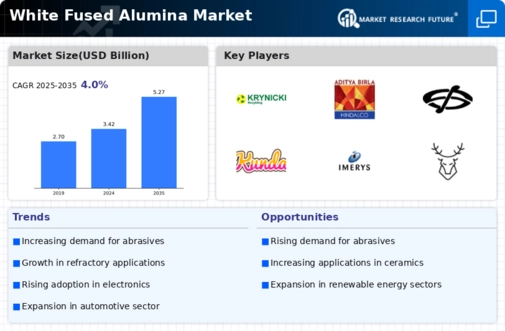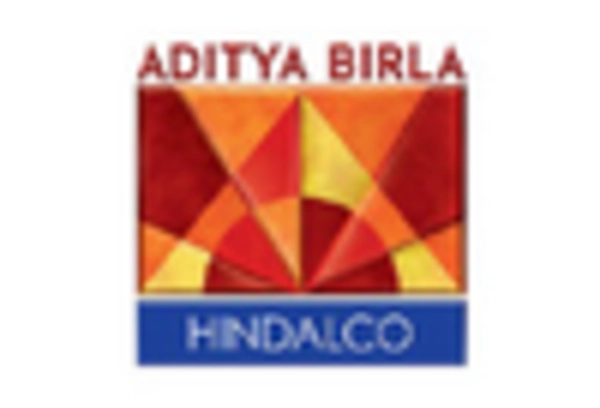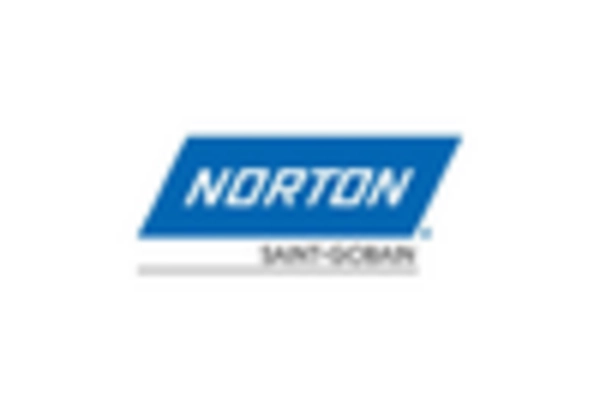Growth in the Electronics Sector
The White Fused Alumina Market is also benefiting from the growth in the electronics sector. As technology advances, the demand for high-purity materials in electronic components is increasing. White fused alumina is utilized in the production of substrates and insulators due to its excellent electrical insulation properties and thermal conductivity. The electronics market is projected to expand significantly, with a CAGR of approximately 6% anticipated over the next few years. This growth is likely to drive the demand for white fused alumina, as manufacturers seek materials that can enhance the performance and reliability of electronic devices. The intersection of these two industries presents a promising opportunity for the white fused alumina market.
Expansion in Refractory Applications
The White Fused Alumina Market is witnessing an expansion in its application within the refractory sector. Refractories are essential for high-temperature processes in industries such as steel, cement, and glass manufacturing. The demand for high-performance refractories is expected to rise, driven by the need for energy efficiency and reduced operational costs. White fused alumina, known for its excellent thermal stability and resistance to chemical attack, is increasingly being utilized in the production of refractory materials. Market data suggests that the refractory segment is anticipated to grow at a CAGR of around 4% in the coming years, further solidifying the position of white fused alumina as a critical component in high-temperature applications.
Rising Demand in Abrasive Applications
The White Fused Alumina Market is experiencing a notable increase in demand driven by its extensive use in abrasive applications. Industries such as metalworking, automotive, and construction are increasingly utilizing white fused alumina for grinding, polishing, and surface preparation. The market for abrasives is projected to grow at a compound annual growth rate (CAGR) of approximately 5% over the next few years, indicating a robust demand for high-quality abrasives. This growth is largely attributed to the rising need for precision and efficiency in manufacturing processes, where white fused alumina's superior hardness and durability make it a preferred choice. As industries continue to prioritize quality and performance, the white fused alumina market is likely to benefit significantly from this trend.
Technological Innovations in Production
The White Fused Alumina Market is poised for growth due to ongoing technological innovations in production methods. Advances in manufacturing processes, such as improved melting techniques and enhanced quality control measures, are leading to higher purity and consistency in white fused alumina products. These innovations not only improve the performance characteristics of the material but also reduce production costs, making it more competitive in various applications. The market is expected to see a rise in the adoption of these advanced production technologies, which could lead to an increase in the overall supply of white fused alumina. As industries continue to seek high-quality materials, the impact of these technological advancements on the white fused alumina market is likely to be profound.
Increasing Focus on Sustainable Practices
The White Fused Alumina Market is increasingly influenced by the global shift towards sustainable practices. Manufacturers are under pressure to adopt environmentally friendly materials and processes, leading to a rise in the use of recycled and sustainable raw materials in the production of white fused alumina. This trend aligns with the broader industry movement towards sustainability, where companies are seeking to reduce their carbon footprint and enhance their corporate social responsibility. Market analysis indicates that the demand for sustainable abrasives and refractories is likely to grow, potentially increasing the market share of white fused alumina as a preferred material. This focus on sustainability may also drive innovation in production techniques, further enhancing the market's appeal.


















Leave a Comment